Gable roof rafter systems

Calculation and installation of the rafter system is something almost no house can do without. You can, of course, make the roof flat, with a single slope angle of only one degree - if only the water would drain. But when arranging an attic or attic, you cannot do without rafters.
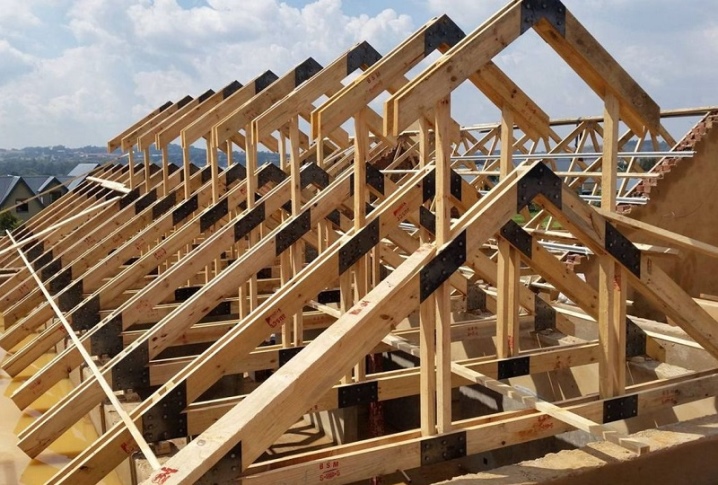
Peculiarities
A gable roof, in contrast to a gable roof, needs a more detailed calculation, since along its middle line (and not only), these slopes keep on each other, delimiting and balancing the load from their real weight. Roof-gable structure - boards, pieces of timber and individual beams of different shapes and cross-sectional areas. For installation, predominantly coniferous beams (for example, pine) are used - unlike larch, it can withstand significantly higher loads. This beam with a side of 15 cm (square section) is laid along each of the load-bearing walls of the structure. Fastening is achieved using anchors, rods with "self-tapping" threads and studs with a diameter of 16 mm or more. This is the Mauerlat - it transfers a uniform load from the rafters to the walls of the building.
It is impossible to install the gable roof rafter beams directly on the walls - especially on foam blocks, gas silicate ones.

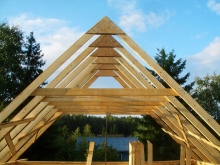
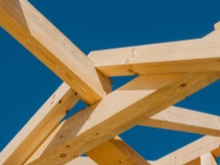
Main elements
Rafter leg - rectangular bar... Section sizes - from 15x10 cm. It is the basis of a triangular-diagonal structure that takes on wind and snow load. The step of the rafter beams under the corrugated board or metal tile is no more than 1.2 m. It is recommended to put them no more than 60 cm apart - the extreme load from a sharply weighted roof can lead the walls to premature cracking. This applies equally to the main buildings, and to their extensions, subsequently erected on the territory next to the house.
Horizontal and vertical vaults (crossbeams) are used for additional reinforcement. Unlike pitched roofs without a ridge, they are required. The horizontal ones protect each of the triangles from swinging and loosening, skewing the roof, subsidence of the ridge, and the vertical ones are not only walls for the attic-attic floor, but also serve as additional stiffeners to prevent vertical subsidence of the roof. Both those and other crossbars are necessary. In the case of a house without an attic, the vertical spacers are set extremely short - not one and a half, but only half a meter high.
Neither a gable nor a four-pitched roof can do without them.
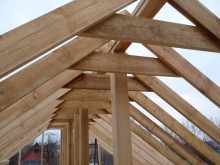
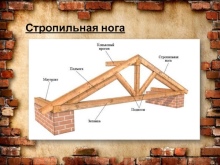
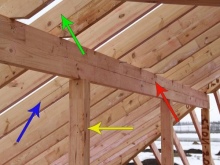
In addition to triangular spacers located in all three corners, so-called horizontal crossbars are used. They serve as beams and the basis for the ceiling and attic flooring, while preventing the triangle of each of the rafter structures, which are spaced from each other, to creep in different directions. They also hold the load of vertical beams that transmit it from the ridge of the roof to the walls of the house and to the ceiling and attic. The material of this base - a beam of 15x15 cm - is the same as for the Mauerlat, but it is permissible to use its reduced version - 10x15.
Finally, the longitudinal spacer (horizontal bar) for the roof ridge runs parallel to its outer deck. It connects the rafter triangles along the upper corner, preventing them from spreading to the sides, like an accordion.There can be three of these spacers - one more on each side.
As a result, all elements of the attic and roof form a reliable and solid foundation.
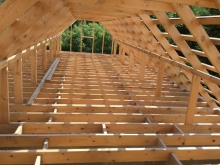
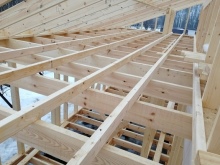

The lathing - it can be made from an unedged board or in some places even from a slab - additionally secures the rafter triangles on top. However, it already serves more for the evenness of the roof, does not allow waterproofing to break. It is also impossible to do without crate. For a softened roof - for example, based on a bituminous underlying layer - assembled from metal tiles, a continuous sheathing of plywood sheets is used.
Skate the gable roof, like the crossbeams parallel to it, is located strictly horizontally. It closes the joint of metal tiles or profiled sheets, located at the highest point of the house.
Overhang protects walls from getting wet during rain. However, it will not protect the same walls insufficiently in case of an oblique downpour in a strong crosswind. It is not recommended to overhang more than 40 cm. If you need to completely protect one of the walls from precipitation, build a canopy next to it connected to the roof.
However, the short overhang can be lengthened if the length of the rafter beams was not enough for the same 40 cm.
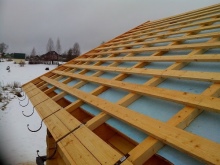

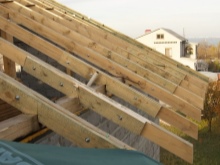
Overview of types of rafters
Roof structures are divided into hanging (outside the outer perimeter of the walls) and layered... Both those and others have found their application in the construction of wooden and monolithic frame houses.

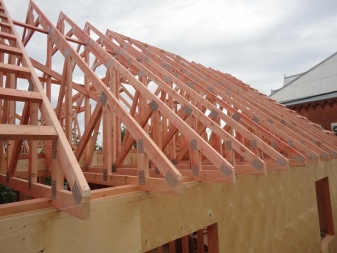
Hanging
Hanging (remote) structures are such that their use is advisable with a roof width of 6 m - it is this distance that is optimal. They are attached to the ridge bar on one side and to the load-bearing wall on the other. The same forces act on them as on any spacer structures. This feature distinguishes hanging rafters from layered ones. They are tightened with wood and metal parts. When installing clamping parts from the bottom side, the function of the support beams is assigned to them.
Be sure to secure these ties as tightly as possible, otherwise the walls will be damaged from falling by the rafter's own weight.
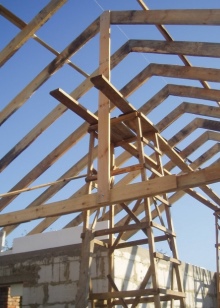
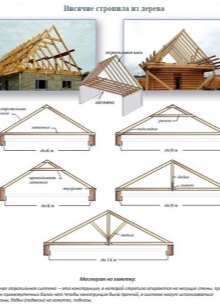
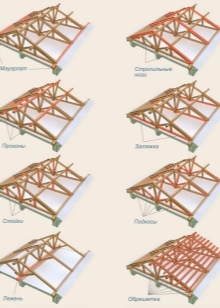
Fortified
The rafter structure is not critical to the distance between longer walls... This is achieved through the installation of a plank element and supporting crossbars. The bed is placed parallel to the Mauerlat - part of the load from the roof assembly is transferred to it. The rafters rest on each other at the highest point of the roof and are supported by supporting vertical beams. Here, the rafter beams resist only bending effects. Their installation is greatly simplified in comparison with hanging ones.
However, they need vertical uprights.
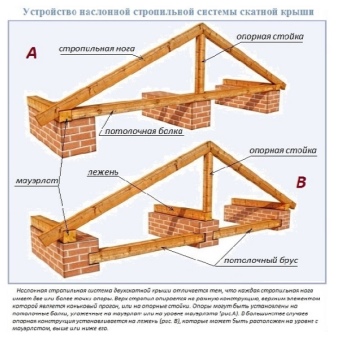
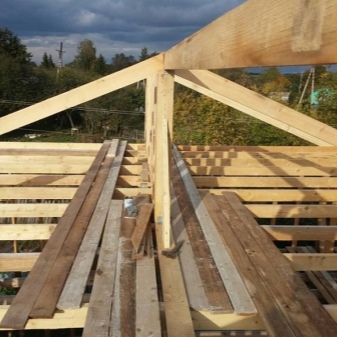
Combined
Combined rafter systems are used, when the roof has a complex shape... To create a stable rafter-beam structure, each of the sections - in some cases - is calculated separately. This makes it possible to achieve the strength and reliability of the ceiling, attic and roof for decades to come. Also, for a log house, it is the combined rafter structures that may be required - on entirely wooden walls, already built from glued or solid timber, a Mauerlat is not required.
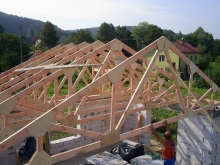
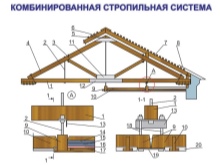

Payment
To recalculate each of the elements of a complex roof faster and more efficiently, use the special offer - construction calculators online. They contain programs for the calculation, the work of users with which excludes all kinds of errors that could become fatal with incorrectly selected data. A finished sketch - or drawing - from which the rafter system is assembled will also be automatically generated. Automated counting makes it possible to determine a number of characteristics:
- roof slope;
- the number and composition of building materials underlain under the roof;
- number and composition of building materials for lathing sheathing;
- weight of building materials and the number, types, types, varieties of structures;
- the length of the rafter beams and their number, the section of the board and / or timber;
- roof area.
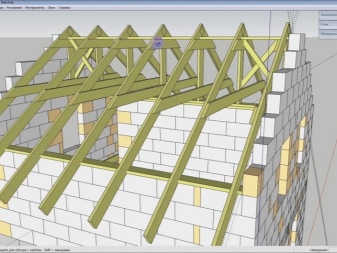
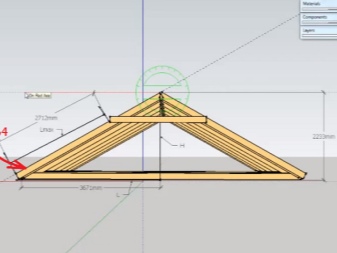
Despite the use of (semi) automatic recalculation, specialists still need practice... Not a single calculator will one hundred percent save an incorrectly calculated amount of materials and structures from premature collapse caused by insufficient knowledge of the strength of materials and disregard of the laws of physics. Self-calculation - with the help of sketches and someone else's experience - although possible, but rather complicated and takes a lot of time. Failure to pay attention to some trifles will result in fatal consequences - from repairs to a complete overhaul of the attic and roof, since uncoordinated loads threaten with subsidence and folding of supporting supports of all varieties, from which the attic-roof tier is assembled.
The slope of the roof is determined by the composition and structure of the roof to be laid, as well as the climate in your area. So, the width of the roof is set by the perimeter of the walls and their location on the ground floor plan. This determines, for example, the height at which the ridge of the roof is located.
The dimensions of the roof, in addition to climatic and weather features, are also determined by the range of building materials used.
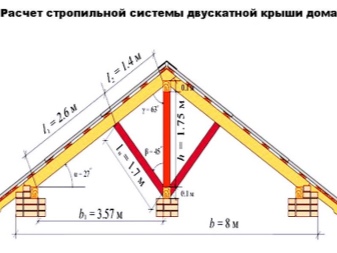
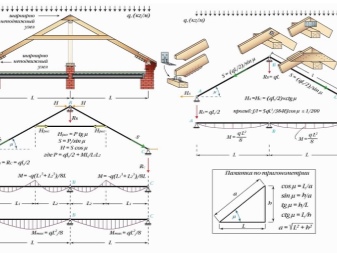
The configuration of the ceiling-attic structure is calculated primarily in accordance with the selected rafter system... Lumber is mainly used here. Before choosing between layered or hanging rafters, decide what spans you should have. Too large spans - more than 1.2 m - can lead to deformation of the structure. To protect against sagging and sagging, craftsmen install fixing parts and additional components, which ultimately give significant rigidity to a large attic structure.
In accordance with the perimeter, length and width of the base (walls, foundation), it is already possible to calculate the width of the roof. For an accurate calculation, use the Pythagorean theorem, familiar to each of the school geometry course: the square of the length of the hypotenuse (rafter beam) is equal to the sum of the squares of the lengths of the legs (transverse rafter beams, divided in two, and the height from their middle to the ridge of the roof). As a result, the total width of the roof is equal to the sum of the values of the main width (above the ceiling and walls) and the overhanging part.
When assembling the structure with your own hands, maintain the absolute equality of the corresponding distances.
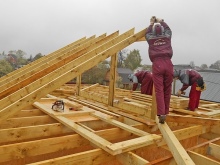
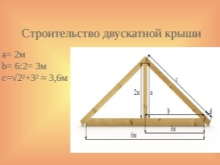
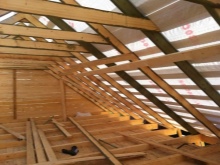
Mauerlat is mounted from a log or beam of sufficient diameter to withstand the total roof load... The overhangs from the eaves are made on the basis of rafter beams, but a ledge formed by the eaves of the walls is also used for them. The width of the overhanging roof area is determined based on the preferred type of roof and wall material in this case. So, the slate overhang should be at least 10 cm, for ceramic tiles its width reaches 60 cm, for a profiled sheet - half a meter. Shingles planted on a bituminous layer will require a 40 cm overhang.
A larger overhang is necessarily reinforced with retaining posts and / or struts.
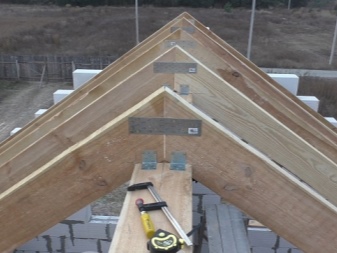
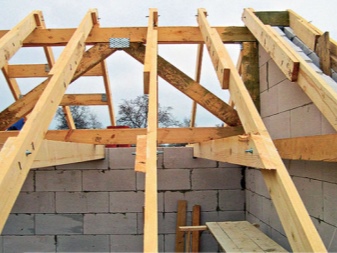
Determining the angle of inclination of the roof - calculating the slope in relation to the horizon. Depending on different sizes and climates, the slope angle ranges from 10-60 degrees. The same value applies for both skates. Symmetry is achieved by mounting slopes of different sizes. The slope of the roof can be calculated based on the following characteristics.
- Coverage, overhang and lathing parameters. The specific roofing option decides which assembly technology is used for the entire assembly.
- Own weight of the roof and all technological structures and layers. A too gentle slope will give a large weight load on the attic ceiling.
- Features of the climate: a larger angle of inclination allows rainwater to drain quickly and snow to fall. The wind resistance will increase.
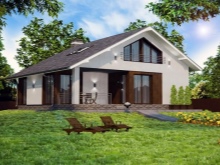
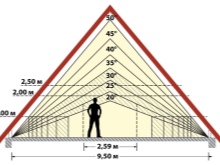
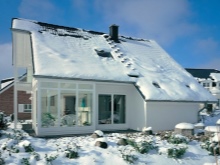
For attic and mansard roofs, the steepness of the roof and the height of the ridge are taken into account. The fact is that, according to most safety requirements, the ridge is at least 1.6 m away from the attic-ceiling ceiling. This height ensures ease of maintenance and fire safety.
Even a complex, multi-level roof with several ridges and peaks should not fall below the 1.6 m mark.
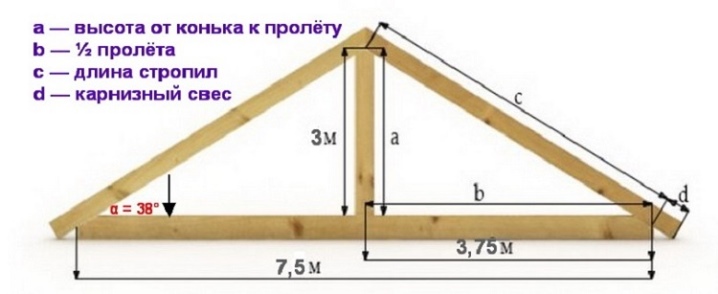
Consumables are calculated based on the general formula for calculating a gable roof. The calculation made before the start of work will require additional amendments during the construction process. Common counting methods are as follows:
- for mauerlat and bed - beams 100x150-200x200 mm, length margin - 5%;
- roof beams - lumber 25x150-100x150 mm, stock length - up to 1/5;
- supports, tightenings, struts - timber or board 50x100-100x100 mm, length margin - up to 10%;
- crate - determined by the type of coating (plywood or board / slab);
- hydroisol - the length of the material in each roll depends on the type of rafter structures, the area of the roof;
- itself coating - determined by the area of the slopes;
- sheathing overhang and pediment components;
- number of fasteners - supplied in packages (screws, anchors, corners, pins, nails).

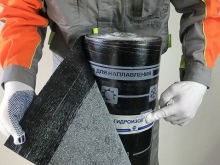
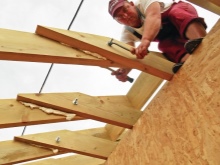
Do not exceed the maximum cross-section of the timber and boards indicated above - the structure will turn out to be too heavy, which at best will create an exorbitant load on the foundation, at worst - will lead to cracking of the walls along the entire height, reminiscent of tectonic faults. Roof pass-through fittings will be required. For example, if the house has a classic stove or wood-burning fireplace, then it is necessary to equip the transition for the chimney in accordance with the fire regulations for the construction of such a firebox.
A warm-roof roof also requires a careful recalculation of heat, steam and waterproofing, counter-lattice, which is no longer attached from above, but from below.
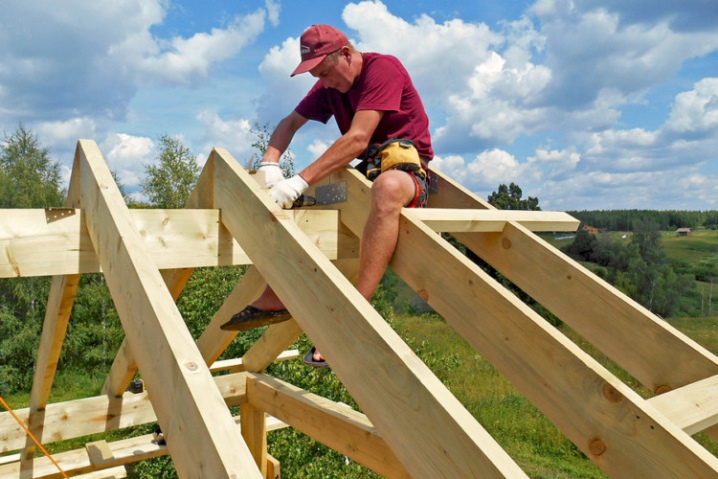
Installation technology
Installation always begins with the installation of a Mauerlat, overlapping beams and rafters with corner beams. For layered and hanging rafters, the assembly technology is significantly different. So, layered rafters are assembled as follows.
- Two extreme supports are installed under the ridge bar. At the same time, they will support the timber, at the same time being the components that create the gable components of the building. Attach them from below to the Mauerlat. They are placed vertically, without errors. The upper ends are aligned horizontally. To set the horizontal, a thread or fishing line is pulled between the props, checking the level. In the presence of distortions, one of the lower supports is raised by means of props.
- Along the horizontal installed with a thread or fishing line, intermediate support posts are installed with an interval of 2.5 m... To prevent the displacement of the rack bars, they are fixed with auxiliary fasteners, which are not installed on a permanent basis. Supports or tightenings act as such parts. A ridge bar is placed on the racks, which is fixed with their own help.
- The rafter beams must be correctly installed in pairs - opposite each other... They can both be cut into the Mauerlat, and auxiliary additional elements can be used - those, in turn, are cut strictly according to the angle of inclination of the slopes. Installation is carried out from either side. The mount is brought in the direction of the ridge and Mauerlat. The distance between the vertical supports is chosen in such a way that the weight and resistance of the roof to the upper loads do not lead to displacement of the rafter beams. At the design stage of the building, this characteristic is finally determined.
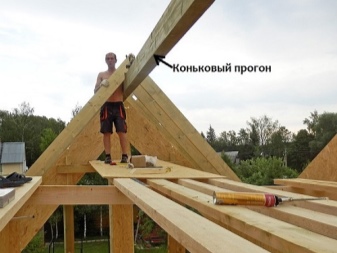
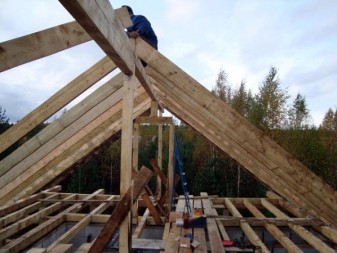
When installing hanging rafters, the assembly of the main fragments is carried out on the ground. The assembly instructions for such a system include the following stages.
- Roof structures are assembled first. - roof, horizontal, vertical and diagonal beams.All of them - one at a time - go upstairs for further installation. Some workers prefer to reinforce them already at the top, on the installed crossbeams of the ceiling. Installation can be carried out one by one - the first assembled one is immediately installed in its place. It is better to use a mobile crane to lift these kits. But its use ultimately increases the cost of building a house.
- The most difficult and responsible step is to display these kits.... To do this, first set the initial and final. The fishing line is pulled along them. The line tension is checked strictly horizontally - without errors. It should also pass along the highest structure - errors in the previous stages of construction can still manifest themselves.
- Rafter assemblies that are below the set horizontal are lifted one after the other... They are already fixed on a permanent basis - this excludes their possible descent and loosening of the structure. Below the rafters - in the places of their fastening - are set horizontally, coinciding with the original installation of the Mauerlat. Before assembling the lathing, the trusses (sets) must be aligned in one plane - from each of both slopes. After completing the assembly of the rafter-lathing structure, waterproofing is placed under the profiled sheet.
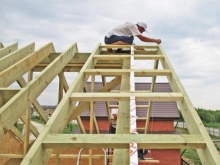
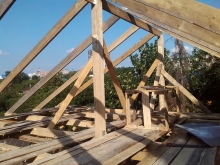
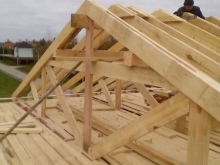
You can find out how to mount the gable roof rafters with your own hands from the video below.













The comment was sent successfully.